Attached files
| file | filename |
|---|---|
| 8-K - 8-K - Synchrony Financial | a8-k3q18102918quarterlyinv.htm |

Exhibit 99.1 3Q 2018 Investor Supplement October 29, 2018

Disclaimers Cautionary Statement Regarding Forward-Looking Statements This presentation contains certain forward-looking statements as defined in Section 27A of the Securities Act of 1933, as amended, and Section 21E of the Securities Exchange Act of 1934, as amended, which are subject to the “safe harbor” created by those sections. Forward-looking statements are based on management's current expectations and assumptions, and are subject to inherent uncertainties, risks and changes in circumstances that are difficult to predict. As a result, actual results could differ materially from those indicated in these forward-looking statements. Factors that could cause actual results to differ materially include global political, economic, business, competitive, market, regulatory and other factors and risks, such as: the impact of macroeconomic conditions and whether industry trends we have identified develop as anticipated; retaining existing partners and attracting new partners, concentration of our revenue in a small number of Retail Card partners, promotion and support of our products by our partners, and financial performance of our partners; cyber-attacks or other security breaches; higher borrowing costs and adverse financial market conditions impacting our funding and liquidity, and any reduction in our credit ratings; our ability to grow our deposits in the future; our ability to securitize our loan receivables, occurrence of an early amortization of our securitization facilities, loss of the right to service or subservice our securitized loan receivables, and lower payment rates on our securitized loan receivables; changes in market interest rates and the impact of any margin compression; effectiveness of our risk management processes and procedures, reliance on models which may be inaccurate or misinterpreted, our ability to manage our credit risk, the sufficiency of our allowance for loan losses and the accuracy of the assumptions or estimates used in preparing our financial statements; our ability to offset increases in our costs in retailer share arrangements; competition in the consumer finance industry; our concentration in the U.S. consumer credit market; our ability to successfully develop and commercialize new or enhanced products and services; our ability to realize the value of acquisitions and strategic investments; our ability to realize the benefits of and expected capital available from strategic options; reductions in interchange fees; fraudulent activity; failure of third parties to provide various services that are important to our operations; disruptions in the operations of our computer systems and data centers; international risks and compliance and regulatory risks and costs associated with international operations; alleged infringement of intellectual property rights of others and our ability to protect our intellectual property; litigation and regulatory actions; damage to our reputation; our ability to attract, retain and motivate key officers and employees; tax legislation initiatives or challenges to our tax positions and/or interpretations, and state sales tax rules and regulations; a material indemnification obligation to GE under the Tax Sharing and Separation Agreement with GE if we cause the split-off from GE or certain preliminary transactions to fail to qualify for tax-free treatment or in the case of certain significant transfers of our stock following the split-off; regulation, supervision, examination and enforcement of our business by governmental authorities, the impact of the Dodd-Frank Wall Street Reform and Consumer Protection Act and the impact of the Consumer Financial Protection Bureau’s regulation of our business; impact of capital adequacy rules and liquidity requirements; restrictions that limit our ability to pay dividends and repurchase our common stock, and restrictions that limit the Synchrony Bank’s ability to pay dividends to us; regulations relating to privacy, information security and data protection; use of third- party vendors and ongoing third-party business relationships; and failure to comply with anti-money laundering and anti-terrorism financing laws. For the reasons described above, we caution you against relying on any forward-looking statements, which should also be read in conjunction with the other cautionary statements that are included elsewhere in this presentation and in our public filings, including under the heading “Risk Factors” in the Company's Annual Report on Form 10-K for the fiscal year ended December 31, 2017, as filed on February 22, 2018. You should not consider any list of such factors to be an exhaustive statement of all of the risks, uncertainties, or potentially inaccurate assumptions that could cause our current expectations or beliefs to change. Further, any forward-looking statement speaks only as of the date on which it is made, and we undertake no obligation to update or revise any forward-looking statement to reflect events or circumstances after the date on which the statement is made or to reflect the occurrence of unanticipated events, except as otherwise may be required by law. Non-GAAP Measures The information provided herein includes a financial measure that is not prepared in accordance with U.S. generally accepted accounting principles (“GAAP”). We refer to “managed-basis” as presenting certain loan performance measures as if loans sold by us to our securitization trusts were never sold and derecognized in our GAAP financial statements. We believe it is useful to consider these performance measures on a managed-basis for 2009 when comparing to similar GAAP measures in later years since we serviced the securitized and owned loans, and related accounts, in the same manner without regard to ownership of the loans. The reconciliation of the managed-basis loan performance measures in this presentation to the comparable GAAP measures for the twelve months ended December 31, 2009 is included at the end of this presentation in “Appendix-Non-GAAP Reconciliations.” 2

Synchrony Financial Overview Leading Consumer Finance Business • A leading Private Label Credit Card (PLCC) provider in US • A leader in financing for major consumer purchases and healthcare services • Long-standing and diverse partner base Strong Value Proposition for Partners & Consumers • Advanced data analytics and targeted marketing capabilities • Dedicated team members support partners to help maximize program effectiveness • Enhanced sales growth and additional economic benefits for partners • Access to instant credit, promotional financing, and rewards for customers Robust Data and Technology Capabilities • Deep partner integration enables customized loyalty products across channels • Partner and cardholder focused mobile payments and e-commerce solutions • Leveraging digital, loyalty, and analytics capabilities to augment growth Attractive Growth and Ample Opportunities • Strong receivables growth • Significant opportunity to leverage long-standing partnerships to increase penetration • Opportunity to attract new partners • Developing broad product suite to build a leading, full-scale online bank Strong Financial Profile and Operating Performance • Solid fundamentals with attractive returns • Strong capital and liquidity with diverse funding profile • Paid quarterly common stock dividend of $0.21 per share in 3Q18 and repurchased $966 million of SYF common stock 3
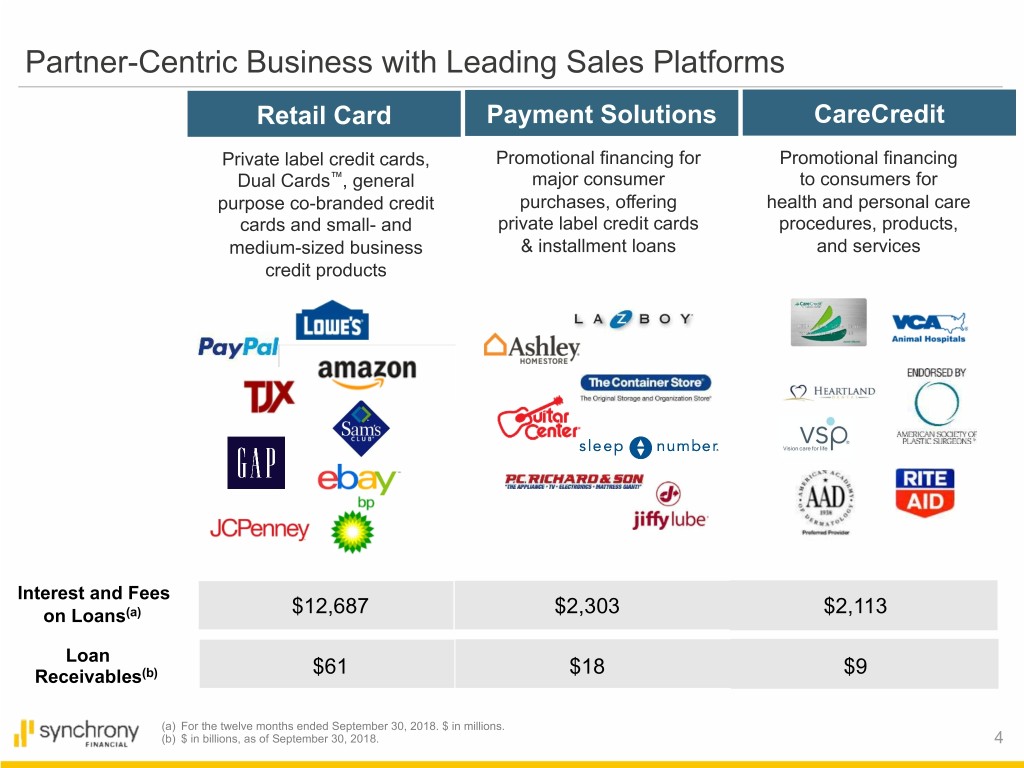
Partner-Centric Business with Leading Sales Platforms Retail Card Payment Solutions CareCredit Private label credit cards, Promotional financing for Promotional financing Dual Cards™, general major consumer to consumers for purpose co-branded credit purchases, offering health and personal care cards and small- and private label credit cards procedures, products, medium-sized business & installment loans and services credit products Interest and Fees on Loans(a) $12,687 $2,303 $2,113 Loan Receivables(b) $61 $18 $9 (a) For the twelve months ended September 30, 2018. $ in millions. (b) $ in billions, as of September 30, 2018. 4
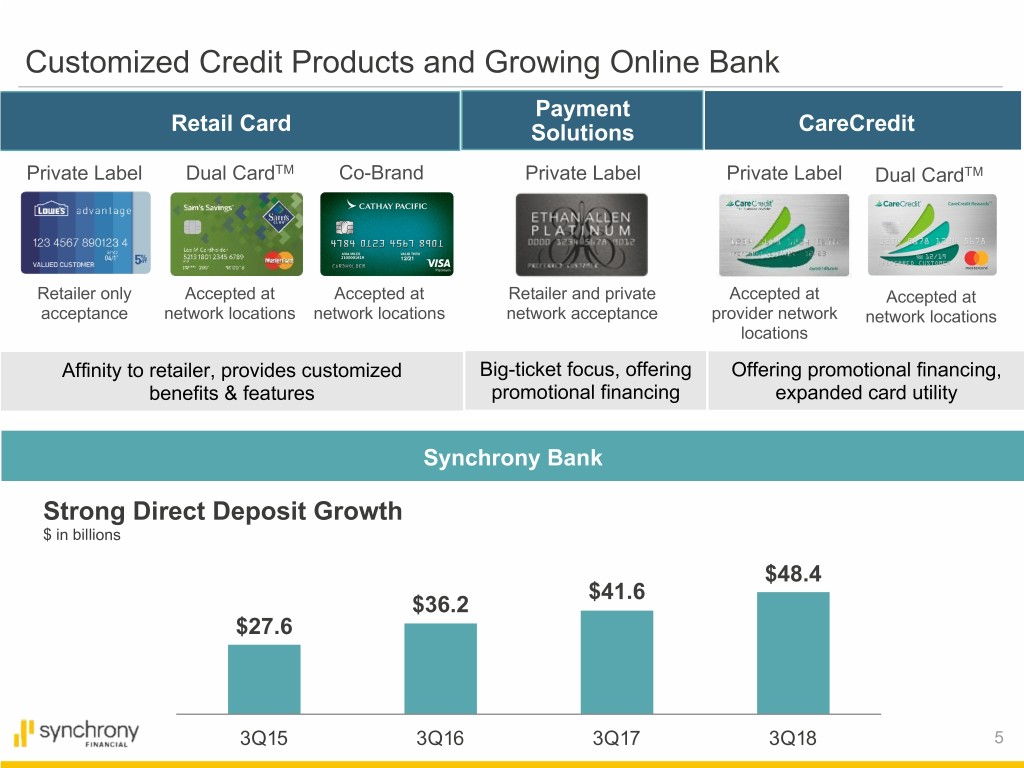
Customized Credit Products and Growing Online Bank Payment Retail Card Solutions CareCredit Private Label Dual CardTM Co-Brand Private Label Private Label Dual CardTM Retailer only Accepted at Accepted at Retailer and private Accepted at Accepted at acceptance network locations network locations network acceptance provider network network locations locations Affinity to retailer, provides customized Big-ticket focus, offering Offering promotional financing, benefits & features promotional financing expanded card utility Synchrony Bank Strong Direct Deposit Growth $ in billions $48.4 $41.6 $36.2 $27.6 3Q15 3Q16 3Q17 3Q18 5

Long-Standing and Diverse Partnerships Average Relationship Length with Ongoing Retail Card Partners is 20 Years Diversified Retail Card Partners Retail Card Interest and Fees on Loans by Retail Market(a) Legend includes a sample of partners, with length of relationship in years at December 31, 2017 Mass Merchandisers E-Retailers 38 13 3% 24 10 13% 12 Specialty Retailers 21 19 Oil & Gas Retailers 17% 48% 10 14 6 4 Department Stores 2 18 19% 12 11 (a) For the year ended December 31, 2017. 6 .
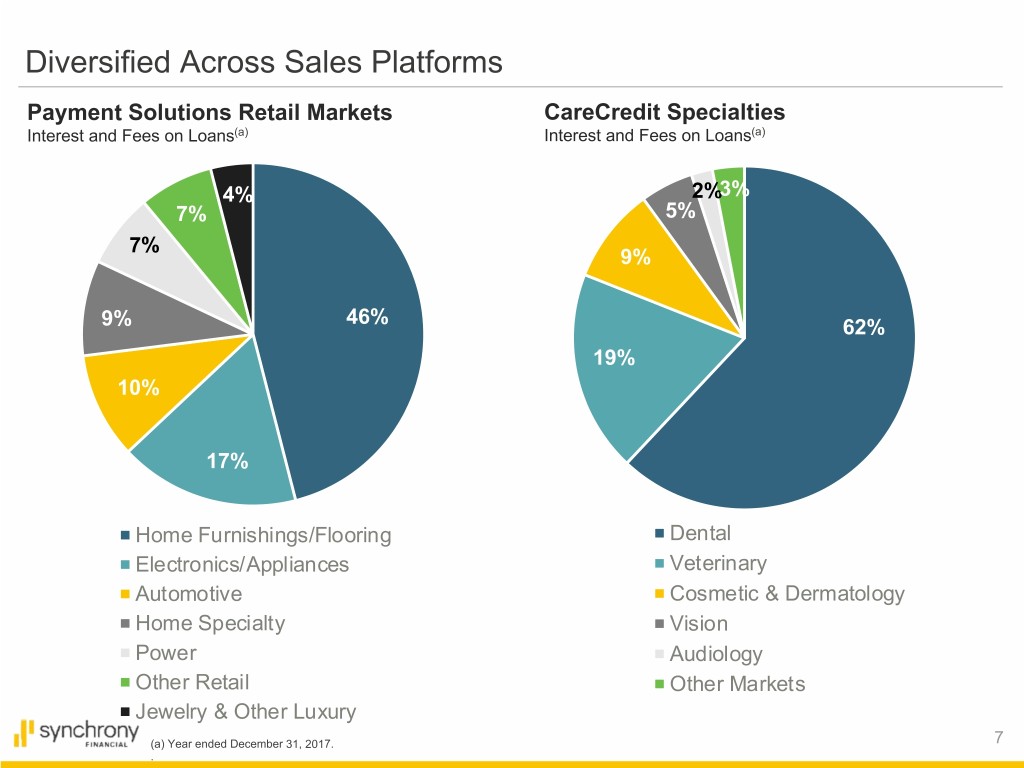
Diversified Across Sales Platforms Payment Solutions Retail Markets CareCredit Specialties Interest and Fees on Loans(a) Interest and Fees on Loans(a) 4% 2%3% 7% 5% 7% 9% 9% 46% 62% 19% 10% 17% Home Furnishings/Flooring Dental Electronics/Appliances Veterinary Automotive Cosmetic & Dermatology Home Specialty Vision Power Audiology Other Retail Other Markets Jewelry & Other Luxury (a) Year ended December 31, 2017. 7 .

Deep Integration Drives 2-3x Market Growth Rate(a) 10.2% 11.9% 9.0% 6.5% 8.5% 3.0% 3.3% 4.1% 5.9% 4.2% 1.3% (1.0)% (b) Mass Electronics Healthcare Apparel/Dept. Home Furniture 2017 Market Size ($ in billions) $551 $339 $259 $202 $247 $109 2012-2017 Market Growth Rate 2012-2017 Synchrony Financial Purchase Volume Growth Rate • Over 85 years of retail heritage • Significant scale across platforms • Robust data capture enables more customized offers • Analytics and data insights help drive growth • Joint executive management of programs—1,000+ SYF FTEs dedicated to drive partner sales • Collaboration with partners ensures sales teams are aligned with program goals • Economic benefits and incentives align goals and drive profitable program growth (a) Market classifications based on industry research definitions. Sources for market data: Kantar Retail (2017 Mass & Apparel/Dept. market projections); IBIS World Research Group; CareCredit industry research; Joint Centers for Housing Studies, Harvard University; Consumer Electronics Association. 8 (b) Synchrony Financial Electronics Purchase Volume excludes hhgregg.
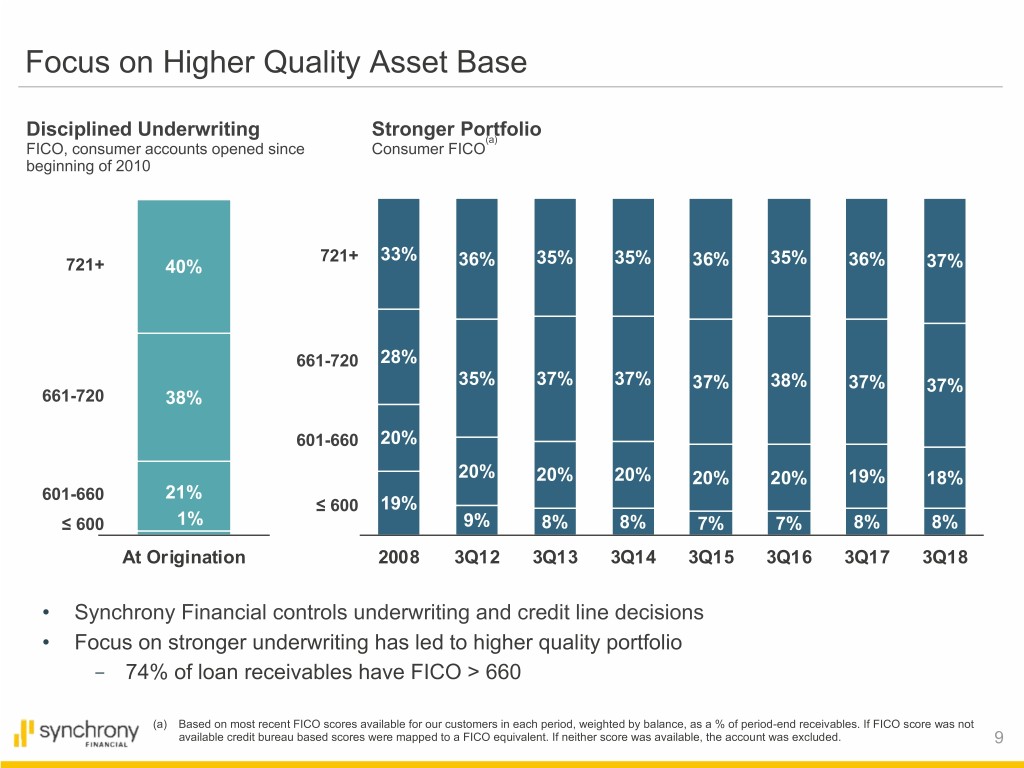
Focus on Higher Quality Asset Base Disciplined Underwriting Stronger Portfolio (a) FICO, consumer accounts opened since Consumer FICO beginning of 2010 721+ 33% 721+ 40% 36% 35% 35% 36% 35% 36% 37% 661-720 28% 35% 37% 37% 37% 38% 37% 37% 661-720 38% 601-660 20% 20% 20% 20% 20% 20% 19% 18% 601-660 21% ≤ 600 19% ≤ 600 1% 9% 8% 8% 7% 7% 8% 8% At Origination 2008 3Q12 3Q13 3Q14 3Q15 3Q16 3Q17 3Q18 • Synchrony Financial controls underwriting and credit line decisions • Focus on stronger underwriting has led to higher quality portfolio - 74% of loan receivables have FICO > 660 (a) Based on most recent FICO scores available for our customers in each period, weighted by balance, as a % of period-end receivables. If FICO score was not available credit bureau based scores were mapped to a FICO equivalent. If neither score was available, the account was excluded. 9
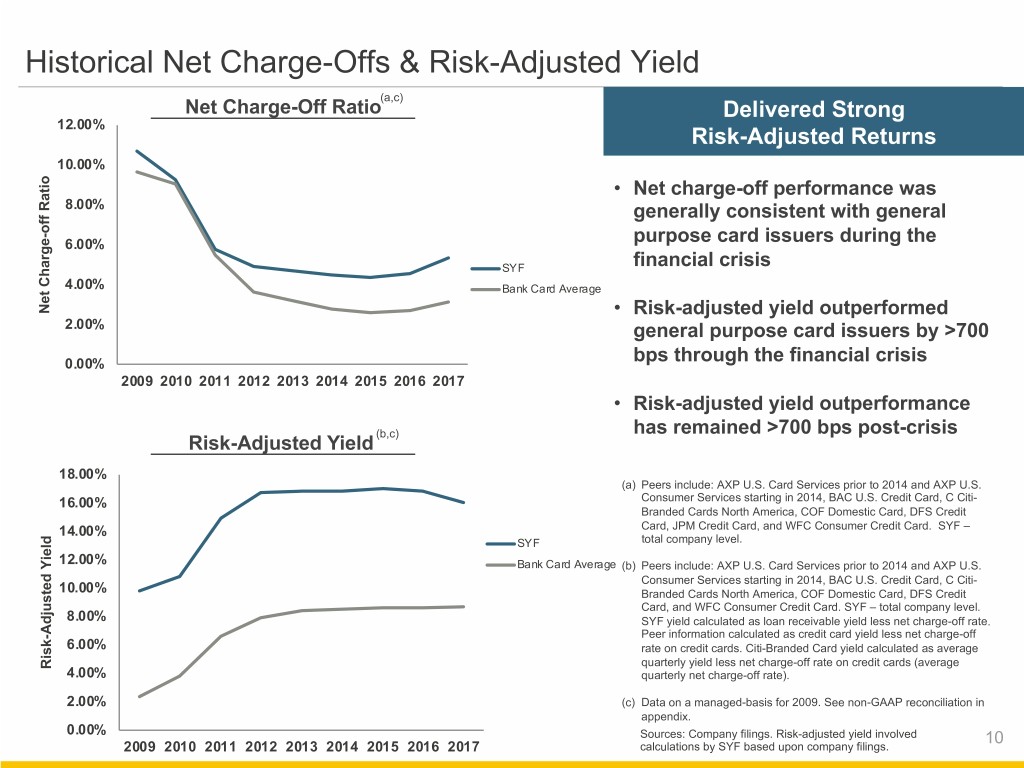
Historical Net Charge-Offs & Risk-Adjusted Yield (a,c) Net Charge-Off Ratio Delivered Strong 12.00% Risk-Adjusted Returns 10.00% • Net charge-off performance was 8.00% generally consistent with general off Ratio - 6.00% purpose card issuers during the SYF financial crisis 4.00% Bank Card Average Net Charge • Risk-adjusted yield outperformed 2.00% general purpose card issuers by >700 0.00% bps through the financial crisis 2009 2010 2011 2012 2013 2014 2015 2016 2017 • Risk-adjusted yield outperformance has remained >700 bps post-crisis Risk-Adjusted Yield (b,c) 18.00% (a) Peers include: AXP U.S. Card Services prior to 2014 and AXP U.S. 16.00% Consumer Services starting in 2014, BAC U.S. Credit Card, C Citi- Branded Cards North America, COF Domestic Card, DFS Credit 14.00% Card, JPM Credit Card, and WFC Consumer Credit Card. SYF – SYF total company level. 12.00% Bank Card Average (b) Peers include: AXP U.S. Card Services prior to 2014 and AXP U.S. Consumer Services starting in 2014, BAC U.S. Credit Card, C Citi- 10.00% Branded Cards North America, COF Domestic Card, DFS Credit Card, and WFC Consumer Credit Card. SYF – total company level. 8.00% SYF yield calculated as loan receivable yield less net charge-off rate. Adjusted Yield - Peer information calculated as credit card yield less net charge-off 6.00% rate on credit cards. Citi-Branded Card yield calculated as average quarterly yield less net charge-off rate on credit cards (average Risk 4.00% quarterly net charge-off rate). 2.00% (c) Data on a managed-basis for 2009. See non-GAAP reconciliation in appendix. 0.00% Sources: Company filings. Risk-adjusted yield involved 10 2009 2010 2011 2012 2013 2014 2015 2016 2017 calculations by SYF based upon company filings.

Retailer Share Arrangements (RSA) Provides a countercyclical buffer in stressed environments: 2013-2017 RSAs were 4.3% of average loan receivables(a) 2009 RSAs were 1.6% of average loan receivables(b) Shared Components Illustrative Examples Operating Program SYF Share of Return Total Program Return Environment Return Retailer Share of Return Allocation 4.0% Program Revenue • Interest Income 2.5% 50% 50% • Fee Income 1.25% • Interchange Fees 2.75% Normal 100% Program Expenses 1.5% • Interest Expense SYF – 69% of Total Program Program Return • Provision for Loan Return Losses • Loyalty Expense • Operating Expenses 2.5% 50% 50% 1.0% 0.50% 1.5% 2.00% 100% Performance Lower Program Program Lower Total Program SYF – 80% of Return Program Return (a) RSA as a percentage of average loan receivables averaged over the five year period. 11 (b) Loan receivables on a managed-basis in 2009. See non-GAAP reconciliation in appendix.
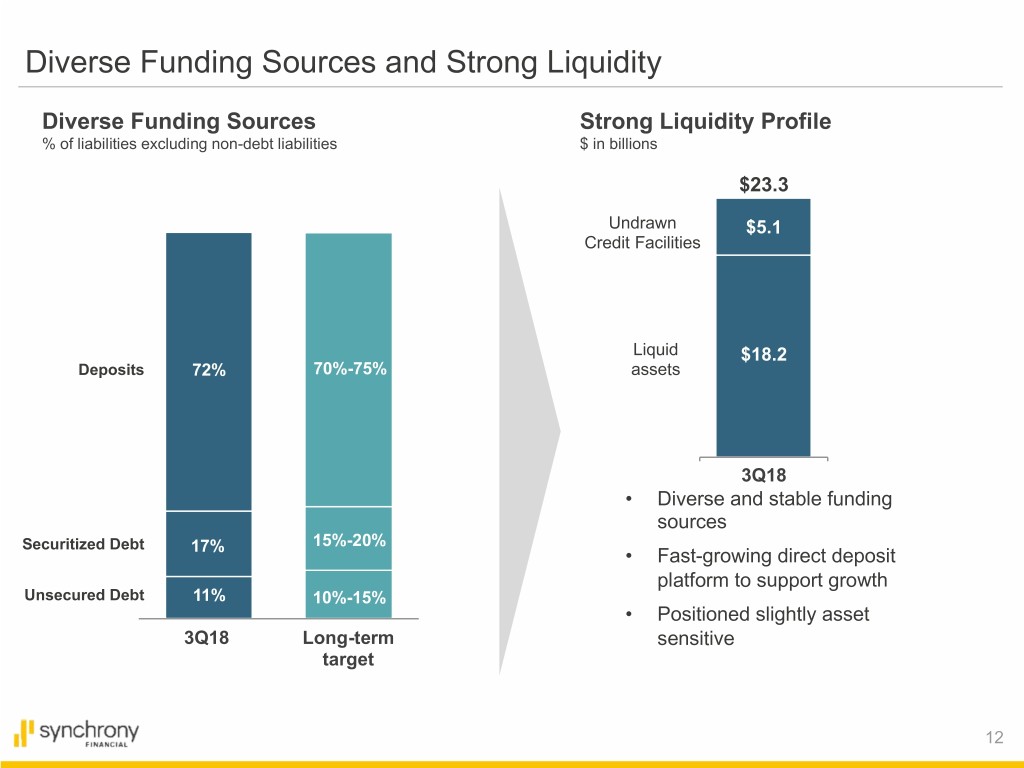
Diverse Funding Sources and Strong Liquidity Diverse Funding Sources Strong Liquidity Profile % of liabilities excluding non-debt liabilities $ in billions $23.3 Undrawn $5.1 Credit Facilities Liquid $18.2 Deposits 72% 70%-75% assets 3Q18 • Diverse and stable funding sources Securitized Debt 15%-20% 17% • Fast-growing direct deposit platform to support growth Unsecured Debt 11% 10%-15% • Positioned slightly asset 3Q18 Long-term sensitive target 12
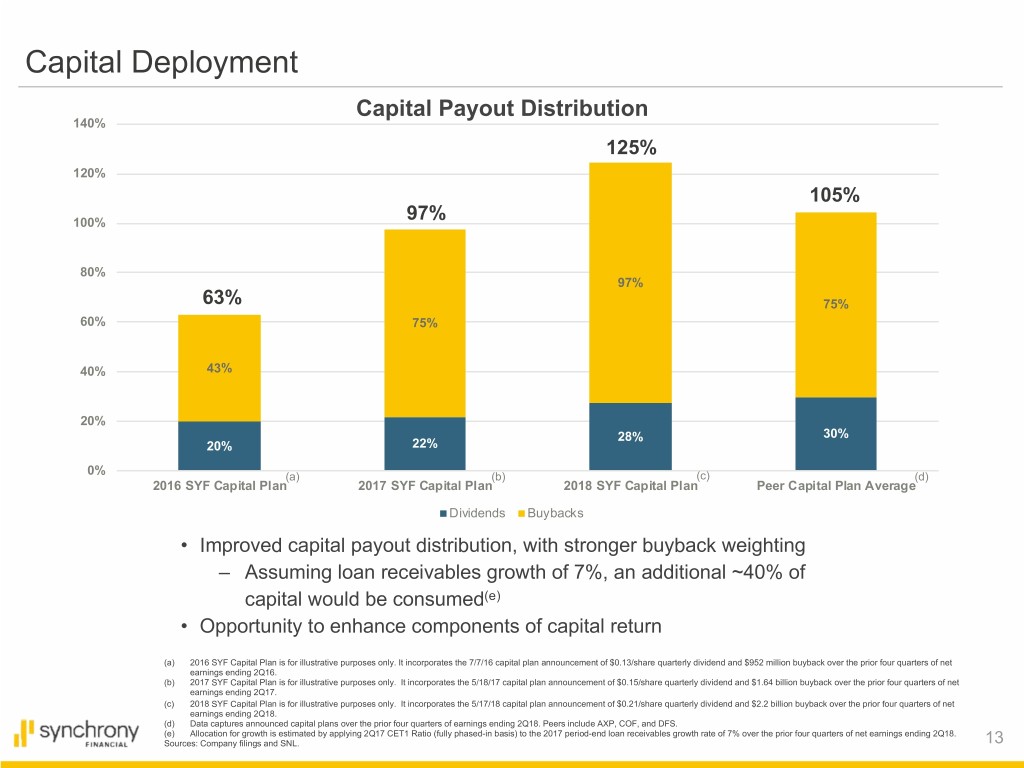
Capital Deployment Capital Payout Distribution 140% 125% 120% 105% 100% 97% 80% 97% 63% 75% 60% 75% 40% 43% 20% 28% 30% 20% 22% 0% (a) (b) (c) (d) 2016 SYF Capital Plan 2017 SYF Capital Plan 2018 SYF Capital Plan Peer Capital Plan Average Dividends Buybacks • Improved capital payout distribution, with stronger buyback weighting ‒ Assuming loan receivables growth of 7%, an additional ~40% of capital would be consumed(e) • Opportunity to enhance components of capital return (a) 2016 SYF Capital Plan is for illustrative purposes only. It incorporates the 7/7/16 capital plan announcement of $0.13/share quarterly dividend and $952 million buyback over the prior four quarters of net earnings ending 2Q16. (b) 2017 SYF Capital Plan is for illustrative purposes only. It incorporates the 5/18/17 capital plan announcement of $0.15/share quarterly dividend and $1.64 billion buyback over the prior four quarters of net earnings ending 2Q17. (c) 2018 SYF Capital Plan is for illustrative purposes only. It incorporates the 5/17/18 capital plan announcement of $0.21/share quarterly dividend and $2.2 billion buyback over the prior four quarters of net earnings ending 2Q18. (d) Data captures announced capital plans over the prior four quarters of earnings ending 2Q18. Peers include AXP, COF, and DFS. (e) Allocation for growth is estimated by applying 2Q17 CET1 Ratio (fully phased-in basis) to the 2017 period-end loan receivables growth rate of 7% over the prior four quarters of net earnings ending 2Q18. Sources: Company filings and SNL. 13

Strategic Priorities Grow our business through our three sales platforms • Grow existing retailer penetration • Continue to innovate and provide robust cardholder value propositions • Add new partners and programs with attractive risk and return profiles Invest in ‘Next Generation’ data, analytics and digital capabilities • Continue to expand the use of advanced analytics to leverage SKU level data to drive sales and customer loyalty • Further develop a frictionless mobile & digitized environment through the use of customer journey insights • Leverage unstructured data and machine learning to drive an even higher level of customer engagement Position business for long-term growth • Explore opportunities to expand the core business (e.g., small business and proprietary networks) • Continue to grow Synchrony Bank — enhance offerings to increase loyalty, diversify funding and drive profitability • Investment in core infrastructure to drive scale, efficiency and agility Operate with a strong balance sheet and financial profile • Maintain strong capital and liquidity • Deliver earnings growth at attractive returns Leverage strong capital position • Organic growth, program acquisitions, and start-up opportunities • Continue capital plan execution through dividends and share repurchase program, subject to Board and regulatory approvals • Invest in capability-enhancing technologies and businesses 14
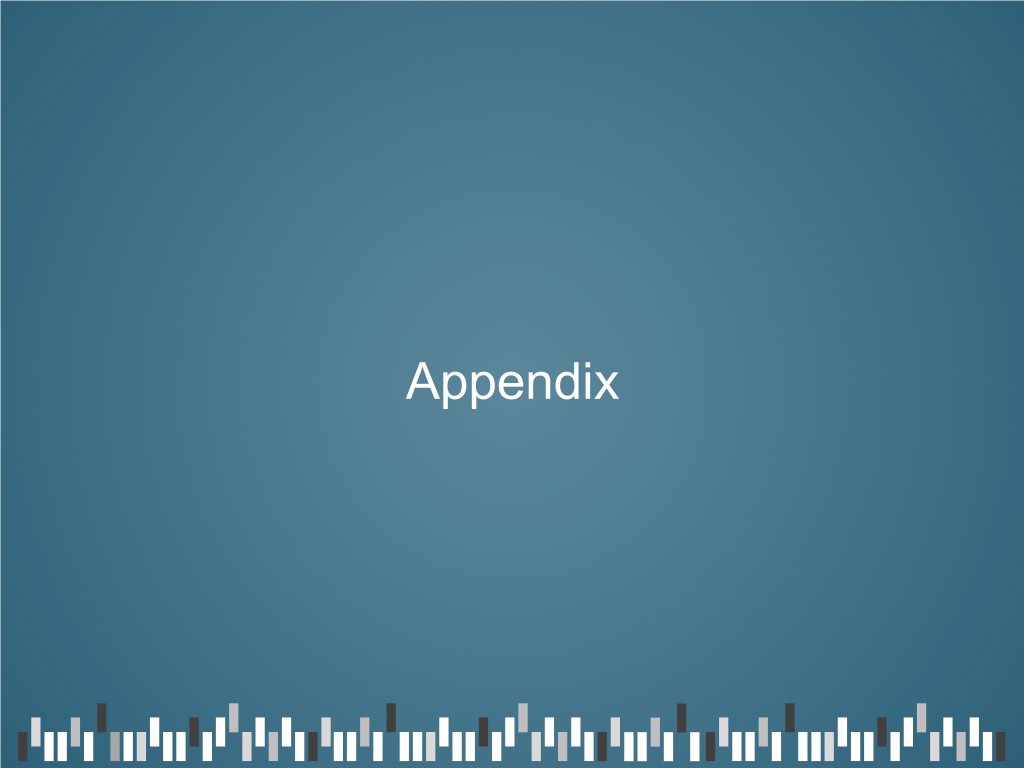
Appendix

Non-GAAP Reconciliation The following table sets forth a reconciliation between GAAP results and non-GAAP managed-basis results for 2009. Twelve months ended December 31, 2009 Net charge-offs as a % of average loan receivables, including held for sale: GAAP 11.3% Securitization adjustments (0.6)% Managed-basis 10.7% Interest and fees on loans as a % of average loan receivables, including held for sale: GAAP 19.7% Securitization adjustments 0.8% Managed-basis 20.5% Retailer share arrangements as a % of average loan receivables, including held for sale: GAAP 3.4% Securitization adjustments (1.8)% Managed-basis 1.6% Risk-adjusted yield(a): GAAP 8.4% Securitization adjustments 1.4% Managed-basis 9.8% (a) Risk-adjusted yield is equal to interest and fees on loans as a % of average loan receivables less net charge-offs as a % of average loan receivables. 16
